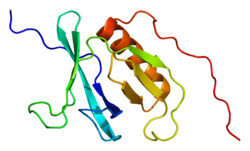Protein-coding gene in humans
CADPS Identifiers Aliases CADPS , CADPS1, CAPS, CAPS1, UNC-31, Ca2+ dependent secretion activator, calcium dependent secretion activatorExternal IDs OMIM : 604667 ; MGI : 1350922 ; HomoloGene : 2755 ; GeneCards : CADPS ; OMA :CADPS - orthologs Gene location (Mouse ) Chr. Chromosome 14 (mouse) Band 14|14 A1 Start 12,372,563 bp End 12,823,079 bp
RNA expression patternBgee Human Mouse (ortholog)Top expressed in Pons Brodmann area 46 prefrontal cortex Brodmann area 9 cerebellar cortex cerebellar hemisphere right hemisphere of cerebellum right frontal lobe superior frontal gyrus postcentral gyrus
Top expressed in pontine nuclei medial vestibular nucleus dorsal tegmental nucleus deep cerebellar nuclei mammillary body ventral tegmental area dorsomedial hypothalamic nucleus superior colliculus medial geniculate nucleus lateral geniculate nucleus
More reference expression data
BioGPS
Wikidata
Calcium-dependent secretion activator 1 is a protein that in humans is encoded by the CADPS gene .
CADPS encodes a novel neural/endocrine -specific cytosolic and peripheral membrane protein required for the Ca2+-regulated exocytosis of secretory vesicles . CADPS acts at a stage in exocytosis that follows ATP-dependent priming, which involves the essential synthesis of phosphatidylinositol 4,5-bisphosphate (PtdIns(4,5)P2). Alternative splicing has been observed at this locus and three variants, encoding distinct isoforms, are described.
References
^ GRCh38: Ensembl release 89: ENSG00000163618 – Ensembl , May 2017
^ GRCm38: Ensembl release 89: ENSMUSG00000054423 – Ensembl , May 2017
"Human PubMed Reference:" . National Center for Biotechnology Information, U.S. National Library of Medicine ."Mouse PubMed Reference:" . National Center for Biotechnology Information, U.S. National Library of Medicine .Walent JH, Porter BW, Martin TF (Oct 1992). "A novel 145 kd brain cytosolic protein reconstitutes Ca(2+)-regulated secretion in permeable neuroendocrine cells". Cell . 70 (5): 765–75. doi :10.1016/0092-8674(92)90310-9 . PMID 1516133 . S2CID 29122392 .
^ "Entrez Gene: CADPS Ca2+-dependent secretion activator" .
External links
Further reading
Nakajima D, Okazaki N, Yamakawa H, et al. (2003). "Construction of expression-ready cDNA clones for KIAA genes: manual curation of 330 KIAA cDNA clones" . DNA Res . 9 (3): 99–106. doi :10.1093/dnares/9.3.99 . PMID 12168954 . Nishizaki T, Walent JH, Kowalchyk JA, Martin TF (1992). "A key role for a 145-kDa cytosolic protein in the stimulation of Ca(2+)-dependent secretion by protein kinase C." J. Biol. Chem . 267 (33): 23972–81. doi :10.1016/S0021-9258(18)35932-5 . PMID 1429734 . Ann K, Kowalchyk JA, Loyet KM, Martin TF (1997). "Novel Ca2+-binding protein (CAPS) related to UNC-31 required for Ca2+-activated exocytosis" . J. Biol. Chem . 272 (32): 19637–40. doi :10.1074/jbc.272.32.19637 . PMID 9289490 . Loyet KM, Kowalchyk JA, Chaudhary A, et al. (1998). "Specific binding of phosphatidylinositol 4,5-bisphosphate to calcium-dependent activator protein for secretion (CAPS), a potential phosphoinositide effector protein for regulated exocytosis" . J. Biol. Chem . 273 (14): 8337–43. doi :10.1074/jbc.273.14.8337 . PMID 9525942 . Berwin B, Floor E, Martin TF (1998). "CAPS (mammalian UNC-31) protein localizes to membranes involved in dense-core vesicle exocytosis" . Neuron . 21 (1): 137–45. doi :10.1016/S0896-6273(00)80521-8 . PMID 9697858 . Hirosawa M, Nagase T, Ishikawa K, et al. (2000). "Characterization of cDNA clones selected by the GeneMark analysis from size-fractionated cDNA libraries from human brain" . DNA Res . 6 (5): 329–36. doi :10.1093/dnares/6.5.329 . PMID 10574461 . Nakayama M, Kikuno R, Ohara O (2003). "Protein-protein interactions between large proteins: two-hybrid screening using a functionally classified library composed of long cDNAs" . Genome Res . 12 (11): 1773–84. doi :10.1101/gr.406902 . PMC 187542 . PMID 12421765 . Strausberg RL, Feingold EA, Grouse LH, et al. (2003). "Generation and initial analysis of more than 15,000 full-length human and mouse cDNA sequences" . Proc. Natl. Acad. Sci. U.S.A . 99 (26): 16899–903. Bibcode :2002PNAS...9916899M . doi :10.1073/pnas.242603899 . PMC 139241 . PMID 12477932 . Cisternas FA, Vincent JB, Scherer SW, Ray PN (2003). "Cloning and characterization of human CADPS and CADPS2, new members of the Ca2+-dependent activator for secretion protein family". Genomics . 81 (3): 279–91. doi :10.1016/S0888-7543(02)00040-X . PMID 12659812 . Speidel D, Varoqueaux F, Enk C, et al. (2004). "A family of Ca2+-dependent activator proteins for secretion: comparative analysis of structure, expression, localization, and function" . J. Biol. Chem . 278 (52): 52802–9. doi :10.1074/jbc.M304727200 . PMID 14530279 . Ota T, Suzuki Y, Nishikawa T, et al. (2004). "Complete sequencing and characterization of 21,243 full-length human cDNAs" . Nat. Genet . 36 (1): 40–5. doi :10.1038/ng1285 . PMID 14702039 . Gerhard DS, Wagner L, Feingold EA, et al. (2004). "The status, quality, and expansion of the NIH full-length cDNA project: the Mammalian Gene Collection (MGC)" . Genome Res . 14 (10B): 2121–7. doi :10.1101/gr.2596504 . PMC 528928 . PMID 15489334 . Binda AV, Kabbani N, Levenson R (2005). "Regulation of dense core vesicle release from PC12 cells by interaction between the D2 dopamine receptor and calcium-dependent activator protein for secretion (CAPS)". Biochem. Pharmacol . 69 (10): 1451–61. doi :10.1016/j.bcp.2005.02.015 . PMID 15857609 . PDB gallery
1wi1 : Solution structure of the PH domain of human calcium-dependent activator protein for secretion (CAPS)
Categories :
Text is available under the Creative Commons Attribution-ShareAlike License. Additional terms may apply.
**DISCLAIMER** We are not affiliated with Wikipedia, and Cloudflare.
The information presented on this site is for general informational purposes only and does not constitute medical advice.
You should always have a personal consultation with a healthcare professional before making changes to your diet, medication, or exercise routine.
AI helps with the correspondence in our chat.
We participate in an affiliate program. If you buy something through a link, we may earn a commission 💕
↑





